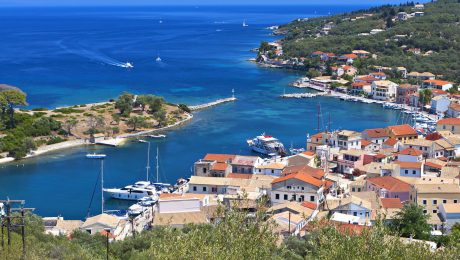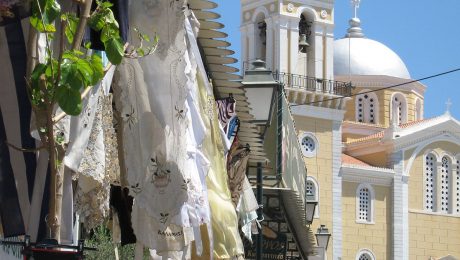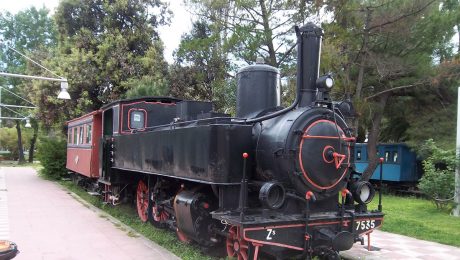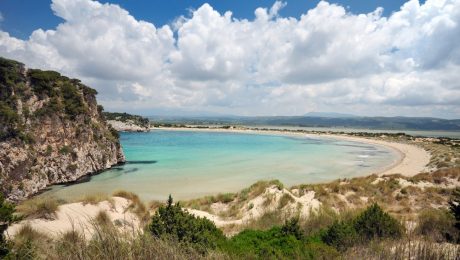Kalamata “The Hostess of Messinia
Below the impressive view of Taygetos, in the surrounding of the Messinian bay, Kalamata invites you to enter in the lively rhythm of living in it.
By airplane or driving, you can reach Kalamata. Before letting go Mani behind you, let your self release to enjoy the charm. Taygetus is majestic is rising from above. The sea shimmering is shining at Kalamatas view . The beach is endless. The vibe of the city will keep you busy: trendy cafes, beach bars, restaurants, luxury hotels, shopping, historical buildings, harbor, an intense nightlife. Kalamata challenges you to start your journey. Everything here is a lively experience, because of the Messinian host ,it was born in a place as blessed as the Peloponnese, it knows well from good life …and how to share it Welcome to Kalamata.
It is worth seeing in Kalamata
The most beautiful beach in the shade of Taygetos
Barefoot in the sand, you will walk a lot and you will indulge in the magic of the endless beach: from Verga to the harbor of Kalamata, this unique beach with a total length of 5 km is spread. Live all day: large hotel units, crowded beach bars , coffee shops, taverns and ouzeries, water sports, amusement parks. Everything is here to guarantee you an unlikely walk by the beach!
A city, a thousand faces
Kalamata does not have one but has many faces. And it’s worth seeing everything. The castle with its walls, the Kalograion monastery, where they still make the famous Kalamatian scarves, the Kalamata Dance Festival, which attracts the eyes of the whole European south, buildings with a neoclassical aura, squares with 19th century temples, shops with branded clothes and accessories, art shops, traditional cafes. This city of Peloponnese will surely surprise you!
Night life and Dolce vita in Kalamata
Kalamata gets ready every night. Shining lights, loud music, chic appearances, powerful car marches and the night-life curtain opens in the heart of the Peloponnese. Take the opportunity and experience the experience until the end … You will not return to the hotel before dawn. Why is Kalamata having fun!
The paths of the city and time
Discover the history of the city, hidden in every street, in every building. Sightseeing will be everywhere in Kalamata: The church of Ypapanti that stands out in the city, with the bells and the silver domes. North of the church, the Municipal Conservatory at Alexandraki Street. At the junction of Kyriakou and Agios Ioannou streets, the neoclassical building that houses the interesting Historical and Folklore Museum.
South, Othon Square, where the central market once operated. On Papazoglou Street, the Municipal Art Gallery in another neoclassic and, almost opposite, the remarkable Archaeological Museum of Kalamata. In the square of 23 March, the historic church of the Holy Apostles: the original temple that houses the sanctuary was built in the Byzantine period. At every step of your story the story in a ride-experience.
The train is coming… in the Railway Park
In one of the first theme parks in Greece, you will almost hear … the train whistling. Wagons, a wagon, passenger and freight wagons of various types, the two-storey building of the Station: all here exudes a retro aura. You will see the water tower with the stone cylindrical base, boarding platforms and a 28 meter-long metal pedestrian bridge.
Ride in Messina
It has the privilege of being only a short distance from the longest sandy beach of the Messinian Gulf. In the center of Messina impresses the park with large trees, fountains and the old clock, surrounded by dozens of restaurants, barbecues, cafes and shops.
The ancient Messina of history and culture
Just 30 km from Kalamata you will find yourself in a shocking archaeological site, one of the most important in the Peloponnese. Ancient Messini dates back to the 4th century. B.C. The archaeological site includes temples, houses, walls and public buildings that are preserved in good condition. You will see, among other things, the wall dating back to the 3rd c. B.C. with the Arkadian Gate and its eight towers, public buildings, the Agora, the temple of Artemis Phosphorus or Orthia, the Stadium, the Hero, the theater, the fountain and the dwellings. Since the summer of 2013 the ancient theater of Messina has been inaugurated and reopened to host cultural events.
- Published in Blog-News
The hidden treasures of Kalamata
The Kalamatian scarf
The local art. the local Kalamatian songs in Greece, Kalamatian scarves continue to be woven on looms. You will find them in the shops around the temple of Ypapanti. Important for you know: the genuine Kalamatian scarf is monochrome.
At the Quilt of Kalamata
Paved, traditional cafes, small shops, barbecues and ouzo bars next to each other. Enjoy a walk in this neighborhood, in one of the most vibrant parts of the historic center of Kalamata.
Secret arcades
Going down Aristomenous Street, you definitely have a pass from the Lontos and Varvoutsis porticos , which are crowded with people and tables.
- Published in Blog-News
The top 5 attractions to see in Kalamata
There are only a few times that we have said that Kalamata is a place to visit throughout the year. It combines mountain and sea, old and new city, classical and modern buildings, bicycle and car and the combinations are not finished …
Apart from its beach, which we have no reason not to admit it is its trademark, it boasts its history and a number of attractions that highlight it and challenge the visitor both from Greece and from all over Greece people.
The Castle of Kalamata
Northwest of Kalamata is built on a rocky hill above the river Nedaon the castle of the city. It was founded during Byzantine times but was reconstructed in the 13th century. A.D. by Godefridos I Villardardino and was his residence and headquarters in Baroness of Baroness.
It consists of two fortifications, the outside and the interior, while its battlements are destroyed. In ancient times, the Pharos hero built there the Acropolis of Pharae, while in the 6th c. A.D. there was built a Christian temple at this point. The castle has the typical form of Byzantine castles and at the highest point of the hill there is a tower with a turbid water tank.
Since the beginning of the 20th century the castle has been formed into a grove, due to the prose writer Zacharias Papantoniou, who served as prefect of Messinia. At the southern end of the castle, in 1950, a small theater was built, which during the summer months hosts performances as well as various other cultural events and events.
Mana – Olive of Kalamata
The “kalamata” plant of the Kalamata variety, the 14-meter-long Mana-Elia of Kalamata is the “unknown” symbol of our city that has been standing for hundreds or thousands of years, reminding everyone of the close relationship between Kalamata and the olive !
This particular olive tree is located on a plot of Peloponnese University (formerly plot of the Center for Agricultural Education – RCEGA – Kalamata), on 85, Lakoniki Str. And was declared a “Nature Conservation Monument” under the decision of the Ministry of Agriculture and Rural Development of 200995/7950/1979 the Decree 121 / TD / 1980.
The perimeter of its trunk is about nine meters long and its age is estimated to be between 800-850 years (and according to a survey by the Messinian forestologist Dr. Panagiotis Bazigos it can reach 1733 years.
The Holy Temple of the Holy Apostles
The well-known Holy Church of the Holy Apostles in our city is one of the most famous monuments associated with the Revolution of 1821. The church is located at “23rd of March” Square, which takes its name from the date that the city of Kalamata was liberated by Turkish conquerors.
The temple itself existed before these events, built during the Byzantine period, from 1050 to 1150 AD. According to a study by the Professor of Byzantine Archeology of the University of Thessaloniki, Mr. Konstantinos Kalokyri, the Church of the Holy Apostles was initially smaller and between 1685 and 1715 AD. expanded.
Municipal Railways of Kalamata
In one of the most central parts of the city is a unique sight. A park with historical significance and special beauty. 54 acres of lakes, lots of greenery, playgrounds, cycle paths, a 28 meter footbridge, basketball and volleyball courts, trains, transit platforms and a stationery (refreshment). It is a theme park – the open-air museum of railways, the only one of its kind in Greece, awarded by the European Commission and known to all the friends of the railways around the world.
It was founded in September of 1986, but due to the devastating earthquake that hit Kalamata at the same time, its completion was in 1990. The site chosen to create this open museum – showroom was the old station “Kalamata – Limen” and the neighboring area of OSE, which at the time of the steam was a place with carvings.
Mills
One of the most characteristic buildings of our city and a cultural heritage monument is the industrial building, which housed the mills, which have been inseparably connected with the history of Kalamata and they are hiding in them important moments of the past. From the data available, it appears that the main building, the cylindrical mill, was built in December 1925. In 1928 the expansion of the facilities began with the supply and installation of the third mill.
The building of “Evangelistria” was built in 1926 and two years later, in 1928, the new building of the “Feradourou – Apostolaki and Co.” mill was built. After 1934 the merger procedures of the two companies began, so two complexes emerged. The first one is next to the port’s reservoir and was called “Evangelistria” or “Epimenian” or “Lower Milos” or “Great Mill”. The second was north (southwest of the current Railway Park) and was known as the “Ferradouros – Apostolaki” Cylinder Mill or “Chersaios” or “Up Mylos” or “Small Mill”.
- Published in Blog-News
Messinia: The ten beaches you should not miss seeing
Kalamata, the capital of Messinia, is one of the most beautiful coastal cities in Greece, and its beach is famous not only for the endless walks, but also for the clear blue waters that cause its visitors to dive! But if you want something different, the countless beaches of Messinia will meet your every need. Cosmic and crowded, isolated or adjacent to the seaside resorts of the area, even world-class beaches like Voidokilia of Pylos, other organized and other deserted are sure to win you – besides its natural beauties, Messinia is famous and for its stunning coastline. Voidokilia
1. Little Mantinia
Located 10 km east of Kalamata, you will find the beach of Mikri Mantinia, in a magnificent location, in front of the homonymous village. Where Taygetos stretches its foothills, it blends with the magnificent blue of the sea and makes beautiful coves drowned in the green. The beach is paved with white pebbles, awarded with the Blue Flag, and there you will find a lifeguard. There are many bars and cafes on the beach, as well as many tavernas that almost touch the sea. Little Mantineia, like the whole eastern coast of the Messinian Gulf, has grown into a major tourist resort in Kalamata. It has many tourist accommodation – hotels and rooms to let – on the sea, while new units are being built that attract visitors in the summer, not only from the region but also from various parts of Greece that come here to enjoy their dives overlooking the imposing Peak.
2. Sandova
It is located in the area of Avia, 12 kilometers from the city of Kalamata in the east. It is one of the most cosmopolitan beaches in the area, with many beach bars, which are organized almost every summer in the summer with famous Djs from Greece and abroad. Evening parties at the beach of Santovas are famous, with small flames on the sandy beach and literally drinks on the beach. It has fine sand, with small pebbles where the sea starts. It is the only beach in the area that has sand, although its width is not very large.
3. Almyros beach
It is one of the most popular and crowded beaches of Kalamata. It is located 6 kilometers east of the city, just before the turn leading to the Messinian Mani. Surrounded by white pebbles, it features sun loungers and umbrellas and naturally pleasing cafes and beach bars. It is ideal for water sports such as water skiing and wind surfing. It also has a beach volleyball court for sports enthusiasts. The scenery on the beach is enchanting: On the one hand the turquoise waters reflect the olives and the palm trees that reach the beach and on the other the imposing Taygetos. And in the background the city of Kalamata …
4. Kalogria
It is the most famous, the busiest and the most organized beach in West Mani. In the summer, especially on weekends, “do not drop a pin”. Foreigners and Greeks flood the wonderful white sandy beach, with deep, shallow, frozen waters, with Taygetos waterfalls underwater to keep it clean. It also has umbrellas and sunbeds, a beach volley court, bars, taverns, water sports and bicycle rental and canoeing. It is ideal for young people, but also for families with young children. If you can stay on Kalogria beach until late afternoon, you will see the sun setting right in front of you, in the water, at one of the best sunsets in Greece. Nikos Kazantzakis lived for two years (1917-1918) on the beach of Kalogria with the legendary hero of his novel “Life and the State of Alexis Zorbas”. At the northern end of the beach there is the house that was left with Zorba, while at the southern end, very close to the sandy beach there is the “Kazantzakis cave” where it found shelter for reading and writing. The cave can be visited today either by swimming or by boat.
5. Stoupa
It is the second busy beach of western Mani after Kalogria. It is located just next to it, right in front of the main street of the settlement of Stoupa. Miami is also called Mani, with turquoise waters, golden fine sand, countless umbrellas and sun loungers and a world that constantly climbs. Despite the crowds, the waters are always crystal clear, as underground rivers that start from Taygetos are flowing underwater here and they are constantly recycling. It is worth having a mask with you to explore the beauties of the sea.
6. Beach of the island
It is the most beloved of the lesser known beaches of West Mani, as it is well hidden at the end of a path between the trees. It is untouched by tourism, essentially disorganized (with only one canteen with tables in the summer months), has white pebbles and turquoise waters. Its characteristic is a large rock that separates it into two and gives natural shade. The most … flexible and adventurous can climb it and then dive into the deep waters. At the beach of Fonea the well-known Gorge of Phoneas or else the gorge of Neapountis, which begins to form from the Vaidenitsa Monastery and ends after about 8 km on the crystal-clear beach.
7. Velika Beach
Two and a half kilometers from the settlement of Velika, passing through a reed stretch, you will find the long and sandy coast. The fine golden sand and trees make it a meeting point for many locals and tourists who want to cool and relax in the waters of the Messinian Gulf. At the edge of the beach there is a large café on the sandy beach that almost touches the sea.
8. Petalidi beach
It is just before the harbor of the seaside settlement. The coast is 300 meters long and is covered with thick pebbles, while the bottom is sandy. At Petalidi Beach, 15 km away from Messina, you will find natural shade from the surrounding trees and a traditional cafe on the seafront to enjoy your coffee while enjoying the beautiful view.
9. Voidokilia
It is the most famous beach of Messinia and one of the most beautiful in all Greece! It is located next to the Gialova lagoon, 10 km from Pylos. This natural bay is of unique beauty: white fine sand extends to a large extent, to the edge of the beach. Its waters are tranquil, turquoise and exotic. To your left, as you see the sea, you see Palaiokastro, at the base of which lies the cave of Nestor. On your right, at the other end of Voidokilia, on the hill, there is a vaulted tomb that is attributed (not yet confirmed) to Thrasimidis, son of Nestor. Low vegetation surrounds the bay, while the sandy beach is filled with beautiful shells – it is enough to sink your hand in the sand!
10. Finikounda
It is located just in front of the settlement of Finikoundas, in the southern part of the prefecture of Messinia. Opposite you can see the small island of Schiza, the largest of Messinian Oinousses. It is awarded Blue Flag for its cleanliness, it is paved with sand and features clean, turquoise waters, warm with no depth, making it an ideal destination for families with young children. Due to the fact that there is everything you need in the settlement you will find it at your feet. The beach is almost always full of people, as the local holidaymakers prefer it.
- Published in Blog-News







